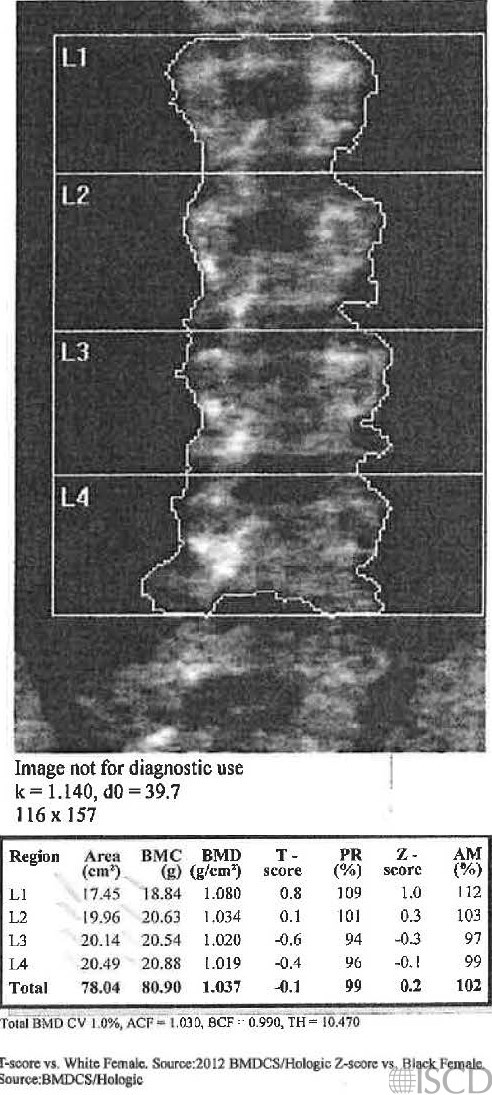This Hologic lumbar spine DXA is from a male to female transgender individual. The data were reported as female.

Case Description:
This is a transgender male to female. This individual was reported out as a female and the physician did not request an alternate analysis.
The ISCD consensus guidelines are pasted in below related to DXA in Transgender and Gender Non-Conforming Individuals:
J Clin Densitom . Oct-Dec 2019;22(4):544-553. doi: 10.1016/j.jocd.2019.07.004. Epub 2019 Jul 10.
Bone Densitometry in Transgender and Gender Non-Conforming (TGNC) Individuals: 2019 ISCD Official Position
Harold N Rosen 1, Ole-Petter R Hamnvik 2, Unnop Jaisamrarn 3, Alan O Malabanan 4, Joshua D Safer 5, Vin Tangpricha 6, Lalita Wattanachanya 7, Swan S Yeap 8
PMID: 31327665 DOI: 10.1016/j.jocd.2019.07.004
DXA in Transgender and Gender Non-conforming Individuals
• Baseline BMD testing is indicated for Transgender and Gender Non-Conforming (TGNC) individuals if they have any of the following conditions:
o History of gonadectomy or therapy that lowers endogenous gonadal steroid levels prior to initiation of hormone therapy.
o Hypogonadism with no plan to take gender-affirming hormone therapy.
o Existing ISCD indications for BMD testing, such as glucocorticoid use and hyperparathyroidism, apply.
• Follow-up BMD testing in TGNC individuals should be done when the results are likely to influence patient management. Examples include:
o Low bone density as defined by current ISCD guidelines.
o Individuals taking treatment to suppress puberty, such as GnRH analogs.
o Non-adherence with or inadequate doses of gender-affirming hormone therapy.
o Plan to discontinue gender-affirming hormone therapy.
o Presence of other risks for bone loss or fragility fracture.
o Bone mineral density testing intervals should be individualized based on each patient’s clinical status: typically, every one to two years until BMD is stable or improved is appropriate, with longer intervals thereafter.
• T- and Z-Score Calculation in TGNC Individuals
o T-scores should be calculated using a uniform Caucasian (non-race adjusted) female normative database for all transgender individuals of all ethnic groups; we recommend using a T-score of <-2.5 or less for diagnosis of osteoporosis in all TGNC individuals age 50 years or older, regardless of hormonal status.
o Calculate Z-scores using the normative database that matches the gender identity of the individual.
o If requested by the ordering provider, Z-scores may also be calculated using the normative database that matches the sex recorded at birth.
o In gender-nonbinary individuals, the normative database that matches the sex recorded at birth should be used.
o Gender data should be obtained on the intake questionnaire.
• The parameters to be included in the DXA report for transgender individuals are the same as are included in reports for the general population, but when specially requested, the report should include Z-scores calculated according to both male and female databases
Credit:
Sarah L Morgan, MD, RD, CCD, The University of Alabama at Birmingham
References:
* Rosen HN et al. Bone densitometry in transgender and gender non-conforming (TGNC) Individuals: 2019 ISCD Official Position J Clin Densitom 22: 544-553, 2019.
*Walcott Q, Dallman J, Crow H, Graves L, Marsh C. DXA scan variants in transgender patients. J Clin Densitom Epub date2022/05/08,
